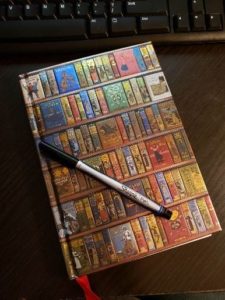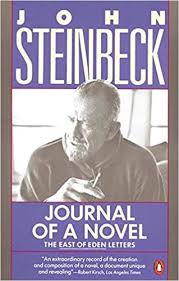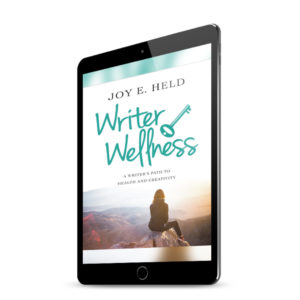
PERKS FOR WRITERS WHO JOURNAL
Wednesday, 4 May 2025
Journaling and writers share a long and important history. From the personal journals of Gustave Flaubert that read like a laundry list of how to view life to the Story Bibles many writers create to keep themselves organized throughout the writing process, writers have always had and always will have numerous reasons to keep a journal. A journal can serve writers of all genres in many different ways, chief among them as a place to collect and hash out story ideas.
It isn’t a waste of valuable writing time to scribble in a journal in advance of working on one’s novel. In the words of author James Brown:
What matters is how journaling can help the writer come up with ideas, kind of a warm-up to a bigger process. The next step is building on those ideas, discarding some and fleshing out others, developing characters and motives, and arranging the scenes in a logical, meaningful sequence with a firm sense of a beginning, middle, and end. Whether you write your thoughts down in a journal or try to store them all in your head, which I don’t recommend, story begins when you begin to dream and brainstorm about people and their problems. (Raab 6)

Then there is the fascinating practice of documenting not only one’s life, but the progress of a book. Two books by John Steinbeck that fundamentally changed the way I look at myself as a writer and a human include Journal of a Novel: The East of Eden Letters and Working Days: The Journals of The Grapes of Wrath. Reading these helped me understand how keeping a journal alongside writing a novel can serve several purposes.
One use for a journal is a place to cleanse the palate, so to speak, before turning to the blank page of the work in progress. Reading snippets about Steinbeck’s faithfully recorded personal life reinforced my feelings on using a journal as a “dumping ground” to clear a writer’s head prior to working on a current project. All too often personal issues can make their way into our creative work and many times that isn’t the appropriate venue for hashing out our problems.
Steinbeck wrote a page or two each morning about his life, thoughts, and sometimes current events in order to “warm-up his writing arm.” He also used the journal pages to organize his thoughts about what to write. For example, one day’s journal describes his plans for writing:
May 9, Wednesday: It is time I think for the book to pause for discussion. It has not done that for a long time. I think that is the way I will do it. That way-first a kind of possible analysis and then quick narrative right to the end, explain it first and then do it. (79)
Steinbeck is just one example of a writer who uses journal writing to stay focused on the creative project at hand. Sue Grafton, prolific mystery author (“A” Is for Alibi) believes that the writing process is a constant back and forth between the right and left-brain hemispheres. She keeps a daily log of her writing progress and says:
This notebook (usually four times longer than the novel itself) is like a letter to myself, detailing every idea that occurs to me as I proceed. Some ideas I incorporate, some I modify, many I discard. The journal is a record of my imagination at work, from the first spark of inspiration to the final manuscript. (Raab 9)
Similar to Steinbeck, Grafton starts each writing day with logging the date into her journal followed by what’s going on in her life then a note about ideas she has for the book she’s writing. She ‘talks to herself’ about where the story could go and explores the writer’s question “What if?” In the privacy and safety of a “for my eyes only” journal, Grafton claims that this collection of meandering thoughts helps her jumpstart the creative juices and before she knows it, she’s writing new pages (Raab 11).
 Sue Grafton
Sue Grafton
What about the time that journal writing “steals” away from the time you could be writing your novel? Expanding on what James Brown says above about “building on those ideas, discarding some and fleshing out others,” your journal is where you can learn about how a character develops in a novel because you have charted your own growth through journaling. Of course, the people in your novels are encapsulated versions, but as novelist and educator Katherine Tucker says of her journals, “I am convinced, though, that the writing of the pages taught me more than I will ever realize, that my years as a journal writer were essential to the work I am doing now, and to the work still to come” (Raab 42).
Journal writing satisfies so many needs of the writer, particularly the fiction author, by acting as a sort of playground for the practice of writing stories. Examining one’s own life is a direct conduit to having a rich, fruitful resource upon which to draw from when it comes time to create the villain, the sweetheart, the teacher, the heroine, the whatever because we have a written record of experience with that character in the pages of our journals. Journaling for writers is a safe place to practice, to record, to play “what if,” to examine, to describe, to report, to praise, to condemn, to lie, to tell the truth, to plan, and discover. The pages of a writer’s journal can serve as a handy resource when describing the realities in novels that entice readers to suspend their lives in favor of riding along with your characters.
The Massive List of Perks & Ideas to Journal About
Keeping a journal doesn’t have any requirements for time spent. In fact, writers can receive a massive number of advantages from regular or spontaneous journaling.
Journaling practice helps writers:
Acknowledge
Blog
Celebrate
Data collection
Develop voice
Documentation of process
Experiment, try new things out away from critical eyes
First drafts
Freedom from the inner critic
Freedom to think
Generate ideas
Healthy self-talk
Improve writing skills
Jumpstart thinking
Knowledge storage
Learn to pay attention
Mental and emotional cleansing
Motivational
Nurture and spark creativity
“Organize a chaotic life” V. Woolf
Organize thinking
Overcome writer’s block
“Parking spot for ideas or problems” D. Raab
Place to scribble
Place to doodle
Plan writing for the day
Quiet the inner critic
Re-examination place
Record activities/daily life/travel/conferences
Record keeping
Record observations on life/people/work/emotions
Safe place to vent/be stupid/self-indulgent
See things from another perspective
Self-knowledge
Self-empowering
Self-development
Solidify thoughts
Story/poem/article ideas
“The author’s other brain” D. Raab
Travel record
Understand
Validate purpose and direction
Write without boundaries
Word collection
Work out problems
X-ray examination, deep look
Yearnings clarified
Zone in on solutions
Can you think of anything to add?
How to Make Use of the Perks in Your Writing
At one time or another, I’ve used all of these perks from my journals in my professional life. As a college writing instructor, I found out quickly how important it is to document the who/what/when/where of things that happened in class. Teaching in higher education is quite a challenge these days, and it paid many times over to have kept a journal of what I planned to teach in class, what actually occurred in the class, and student behaviors (attendance, participation, etc.) After 14 years of tracking my English composition classes, I wrote a short story about an incident on a college campus in which I created my characters, descriptions, settings, plot entirely from my notes as a college educator.
I’ve also noticed my writing voice in nonfiction and fiction develop from how I “write to myself” in my journals. I experiment with form, shape, sentence structure, word choice, punctuation, and ideas in my journal and have seen those trials appear in my blogging and my fiction.
Art hasn’t ever been one of my strong points, but I’ve always had the urge to doodle and draw. My journals allow me to play around with forms and designs that then get transferred to my professional work. I was introduced to art journaling several years ago and loved the process of combining words with art. I took my love of scrapbooking and put it together with stories or journal entries and found a surprising amount of “artistic satisfaction.” When my nonfiction book Writer Wellness: A Writer’s Path to Health and Creativity was released in its second edition in 2011, I added a chapter about how to incorporate art journaling techniques to a regular journaling habit.
I keep a word journal filled with words I like the sound of, want to know the meaning of, or plan to use in a novel. When I read anything from the cereal box to fiction, I write a word or two in my word journal and refer to it when I want something fresh or appropriate for my writing.
If you’re already a fan or regular practitioner of journaling, you will understand when journal therapy teacher Kathleen Adams says,
There’s a friend at the end of your pen which you can use to help you solve personal or business problems, get to know all the different parts of yourself, explore your creativity, heal your relationships, develop your intuition…and much more.
The possibilities are endless as long as I continue to collect my thoughts, ideas, and random musings in a journal.
The many joys of keeping a journal for writers is a lengthy list. The three writers highlighted here (Steinbeck, Grafton, and Brown) demonstrate how valuable a tool this is for brainstorming, whining, organizing, formalizing, clarifying, reflecting, and much more.
Writer or not, do you journal?
Be well, write well!
~Joy
Connect with me on social media. The links are in the top right corner of this site. Sign up for my newsletter to keep up date.
Works Cited
Raab, Diana M., ed. Writers and the Notebooks. The University of South Carolina Press, 2010.
Steinbeck, John. Journal of a Novel: The East of Eden Letters. Penguin Books, 1990.
Advertisements

My WriteDay subscription box for writers mywriteday.com. Subscriptions open for new subscribers on June 30!
My WRITEDAY is a subscription box program that delivers curated products from authors, creators, and small businesses to writers and readers in the continental U.S. It’s unique in that many products are sourced from writers who are also crafters and artisans. Each box delivers a writing craft book and 3-7 items associated with the key concepts (journaling, fitness, relaxation, nutrition, and/or creative play) of Writer Wellness, my flagship program and book (Headline Books, Inc. 2020.)
Each box is inspired by literary themes, genres, and holidays. Every box includes access to My WRITEDAY Digital Magazine filled with writing and publishing tips, writer wellness ideas, fiction excerpts, poetry, special offers, social media options such as live virtual meetings, and more.
The idea behind My WRITEDAY is to help writers spend more time creating stories, engaging with like-minded book friends, and enjoying the juicy, creative life they deserve. From craft books to office supplies to fun, writing/reading inspired décor, subscribers ages 14 and up will discover an experience designed to offer a healthy plan for living their best writing life. The cost per box is $59.00 and includes free shipping (in the continental U.S.). There are discounts available on the website. Please visit us!

Disclaimers
This article may contain affiliate links which may result in the author receiving a commission when readers purchase items through the links.
You are receiving this message because you previously signed up for notifications or participated in a program/course with Joy. You may unsubscribe at any time.
My ideas are not ever meant as a substitute for consulting with a qualified health professional.


